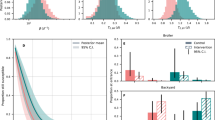Abstract
BOVINE abortion is a major cause of economic loss to the dairy industry in the United States and elsewhere; estimates suggest that from 1.5 to 5.5% of all dairy cattle pregnancies terminate in abortions, the cause of which is largely unknown1–3. Many causes of bovine abortion are recognized4 and diagnostic methods are well established, but in most laboratories only 20 to 30% of these abortions are diagnosed1–7. We report here the results of investigations of the possibility that feed contaminated with mycotoxin is a cause of previously undiagnosed bovine abortion. Recognized diagnostic procedures revealed the causes of twenty-six8 out of fifty nonselected cases of bovine abortion referred to the Wisconsin State Animal Health Laboratory. Feed from the remaining farms was collected, dried, ground and fed to pregnant rats and rabbits to establish a possible relationship between feed and abortion. Feeds from several such herds induced foetal death and resorption in the test animals.
This is a preview of subscription content, access via your institution
Access options
Subscribe to this journal
Receive 51 print issues and online access
$199.00 per year
only $3.90 per issue
Buy this article
- Purchase on Springer Link
- Instant access to full article PDF
Prices may be subject to local taxes which are calculated during checkout
Similar content being viewed by others
References
Dairy Cattle Abortion. Special Request and Information Form (New York State Veterinary College, Ithaca, New York, January 9, 1962).
Notes from the Extension Veterinarian for July 1966 (Cooperative Extension Service, Kansas State College, 1966).
Research Reports: Calving Statistics, Feedstuffs (42, 26) (1970).
Faulkner, L. C., Abortion Diseases of Livestock, 75 (Thomas Springfield, Illinois, 1968).
Report of the Animal Health Laboratories, Wisconsin Department of Agriculture (1965–1966, 1966–1967).
Weikl, A., Berl. Munch. Tierarztl., 77, 293 (1964). (Abstr. in Vet. Bull., 35, 21, 1965).
Bolton, W. D., Durrell, W. B., Wadsworth, J. R., and Murray, R. W., Amer. Vet. Med. Assoc., 155, 500 (1969).
Macklin, A. W., thesis, Univ. Wisconsin (1971).
Van der Merwe, K. J., Steyn, P. S., Fourie, L., Scott, D. B., and Theron, J. J., Nature, 205, 1112 (1965).
Van Walbeek, W., Scott, P. M., Harwig, J., and Lawrence, J. W., Canad. J. Microbiol., 15, 1281 (1969).
Chu, F. S., and Butz, M. E., J. Assoc. Offic. Anal. Chemists, 53, 1253 (1970).
Moore, J. H., and Truelove, B., Science, 168, 1102 (1970).
Kalter, H., and Warkany, J., Physiol. Rev., 39, 69 (1959).
LeBreton, E., Frayssinet, C., LaFarge, C., and deRecondo, A. M., Food Cosmet. Toxicol., 2, 675 (1964).
Waugh, D., and Pearl, M. J., Amer. J. Pathol., 36, 431 (1960).
Fratta, I., Zak, S. B., Greengard, P., and Sigg, E. B., Science, 145, 1429 (1964).
diPaolo, J. A., Elis, J., and Erwin, H., Nature, 215, 638 (1967).
Butler, W. H., and Wigglesworth, J. S., Brit. J. Exp. Pathol., 47, 242 (1966).
Purchase, I. F. H., and Nel, W., in Biochemistry of Some Food-borne Microbial Toxins (edit. by Mateles, R. I., and Wogan, G. N.), 153 (MIT Press, Cambridge, 1967).
Theron, J. J., Van der Merwe, K. J., Liebenberg, N., Joubert, H. J. B., and Nel, W., J. Pathol. Bact., 91, 521 (1966).
Pitout, M. J., Toxicol. Appl. Pharmacol., 13, 299 (1968).
Scott, P. M., van Walbeek, W., Harwig, J., and Fennell, D. I., Canad. J. Plant. Sci., 50, 583 (1970).
Carlton, W. W., Tuite, J., and Mislivec, P., Tox. Appl. Pharmacol., 13, 372 (1968).
Krogh, P., and Hasselager, E., Arsskr. K. Vet-Landbohjsk., 198 (1968).
Shotwell, O. L., Hesseltine, C. W., and Goulden, M. L., J. Assoc. Offic. Anal. Chemists, 52, 81 (1969).
Allcroft, R., and Roberts, B. A., Vet. Rec., 82, 116 (1968).
Allcroft, R., Rogers, H., Lewis, G., Nabney, J., and Best, P. E., Nature, 209, 154 (1966).
Allcroft, R., Roberts, B. A., and Lloyd, M. K., Food Cosmet. Toxicol., 6, 619 (1968).
de Iongh, H., Vles, R. O., and Van Pelt, J. G., Nature, 202, 466 (1964).
Masri, M. S., Lundin, R. E., Page, J. R., and Garcia, V. C., Nature, 215, 753 (1967).
Author information
Authors and Affiliations
Rights and permissions
About this article
Cite this article
STILL, P., MACKLIN, A., RIBELIN, W. et al. Relationship of Ochratoxin A to Foetal Death in Laboratory and Domestic Animals. Nature 234, 563–564 (1971). https://doi.org/10.1038/234563a0
Received:
Revised:
Issue Date:
DOI: https://doi.org/10.1038/234563a0
This article is cited by
-
Interference of Mycotoxins with Prenatal Development of the Mouse
Acta Veterinaria Scandinavica (1981)
-
Methode zur Ochratoxin-A-Bestimmung in Lebens- und Futtermitteln mittels Hochdruckfl�ssigkeitschromatographie (HPLC)
Zeitschrift f�r Lebensmittel-Untersuchung und -Forschung (1980)
-
Biological activities of mycotoxins
Mycopathologia (1978)
-
Effects of rubratoxin B on prenatal development in mice
Bulletin of Environmental Contamination and Toxicology (1973)
Comments
By submitting a comment you agree to abide by our Terms and Community Guidelines. If you find something abusive or that does not comply with our terms or guidelines please flag it as inappropriate.



